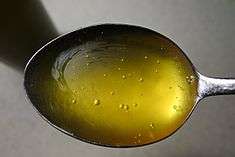Perilla oil
 | |
| Nutritional value per 100 g (3.5 oz) | |
|---|---|
| Energy | 884 kcal (3,700 kJ) |
|
100 g | |
| Saturated | 6-10 g |
| Monounsaturated | 12-22 g |
| Polyunsaturated |
65-86 g 52-64 g 14 g |
| |
| Percentages are roughly approximated using US recommendations for adults. | |
Perilla oil, also called deulgireum(들기름, Korean pronunciation: [tɯl.gi.ɾɯm]),[1] is an edible vegetable oil derived from the seeds of deulkkae(Perilla frutescens var. frutescens). Having a distinctive nutty aroma and taste, perilla oil is used as a flavour enhancer as well as a cooking oil in Korean cuisine.
Nutrition
Deulkkae seeds are a rich source of oil, with about 38-45% lipid.[2][3][4]
Saturated fatty acids in perilla oil are mainly palmitic(5-7%) and stearic(1-3%). Monounsaturated fatty acids in perilla oil are oleic(12-22%), while polyunsaturated fatty acids in perilla oil are linoleic(13-20%), gamma-linolenic(0-1%), alpha-linolenic(54-64%), and arachidic(0-1%). Perilla oil is considered an alternative source of fatty acids that contains both saturated and unsaturated fatty acids.
In comparison to other plant oils, perilla oil exibits one of the highest proportion of omega-3 fatty acids, which is at 54-64%.[5] The omega-6 fatty acid component is usually around 14%. This unusual omega-6:omega-3 ratio (in favour of omega-3), beneficial to human health and in prevention of various diseases like cardiovascular disorders, cancer, inflammatory and rheumatoid arthritis, etc.,[6] makes perilla oil a healthier alternative to other seed oils.[7]
Use
Culinary use

(stir-fried perilla leaves in perilla oil)
Toasted and untoasted perilla oil is used as cooking oil and condiment, mainly in Korean cuisine.
Korea
Koreans use perilla oil for marinating namul, coating gim(a kind of laver), or pan-frying jeon(fried pancake). Culinary use of perilla oil is more common in the southern part of Korea as perilla is not cultivated in the colder northern areas.[8]
Non-culinary use
Medical
In parts of Asia, perilla oil is used as an edible oil that is valued more for its medicinal benefit than its flavour.
Industrial
Perilla oil is used along with synthetic resins in the production of varnishes. Perilla oil dries faster than linseed oil and on drying forms a film that is harder and yellows more than that formed by linseed oil. The paint and varnish industry accounts for the largest usage. Perilla oil also is important in the manufacture of printing inks and linoleum, and in more ancient times was a critical component in creating durable earthen floors.
In Japan, perilla oil was important for fueling oil lamps until around the Sengoku period (early 16th century),[9] before it was overtaken by rapeseed oil. The oilseed contains drying oil elements and imported in bulk as a substitute for linseed oil into the United States from Japan, until the supply was interrupted by war.[10]
Use of press cake
The press cake remaining after pressing perilla oil is used as fertiliser or animal feed.
References
- ↑ "들기름" [perilla oil]. Basic Korean Dictionary (in Korean). National Institute of Korean Language. Retrieved 4 December 2016.
- ↑ Shin, Hyo-Sun (1997). "9. Lipid Composition and Nutritional and Physiological Roles of Perilla Seed and its Oil". In Yu, He-Ci; Kosuna, Kenichi; Haga, Megumi. Perilla: The Genus Perilla. London: CRC Press. p. 93. ISBN 9789057021718 – via CRCnetBASE.
Perilla seed contains about 38-45% of lipid (Sonntag, 1979; Vaughan, 1970).
- ↑ Sonntag, Norman O.V. (1979). "Fat splitting". Journal of the American Oil Chemists’ Society. 56 (11): 729a–732a. doi:10.1007/BF02667430. ISSN 0003-021X – via Springer.
- ↑ Vaughan, John G. (1970). The Structure and Utilization of Oil Seeds. London: Chapman & Hall, Ltd. pp. 120–121.
- ↑ Vaughan, John G.; Geissler, Catherine A. (2009). The new Oxford book of food plants (PDF). Oxford, England: Oxford University Press. ISBN 9780199549467.
- ↑ Asif, Mohammad (2011). "Health effects of omega-3,6,9 fatty acids: Perilla frutescens is a good example of plant oils". Oriental Pharmacy & Experimental Medicine. 11 (1): 51–59. doi:10.1007/s13596-011-0002-x. ISSN 1598-2386. PMC 3167467
 . PMID 21909287 – via Springer.
. PMID 21909287 – via Springer. - ↑ Lands, William E.M. (2005). Fish, Omega-3 and Human Health (PDF) (2 ed.). Champaign, Illinois: AOCS Press. ISBN 1893997812 – via کشاورزی و امنیت غذایی می باشد.
- ↑ Pettid, Michael J. (2008). Korean Cuisine: An Illustrated History. London: Reaktion Books Ltd. p. 45. ISBN 9781861893482.
In addition to the three jang described above, other seasonings are highly important in Korean cuisine. Sesame oil (ch’am kiru˘m) and perilla oil (tu˘l kiru˘m) are the chief oils used in preparing foods, sauces and dipping sauces. Sesame oil, made by crushing sesame seeds, has a fragrant scent that accents the taste of food and is used in the preparation of meats and vegetables. Perilla oil, produced by crushing perilla seeds, is more common in the southern parts of the peninsula as perilla is not cultivated in the colder northern areas. Like sesame oil, this oil has a delicate fragrance, and is commonly used to prepare vegetable side dishes. It is also used as a dipping sauce for meats. These two oils are also used to lightly coat sheets of laver, a type of seaweed, before roasting, creating a popular and nutritious side-dish.
- ↑ Gay, Suzanne (2009). The Lamp-Oil Merchants of Iwashimizu Shrine: Transregional Commerce in Medieval Japan. Monumenta Nipponica, 64:1, 1–51. p. 14
- ↑ Brenner 1993, etc.
- PDR Health
- Brenner, D.M. 1993. Perilla: Botany, uses and genetic resources. p. 322-328. In: J. Janick and J.E. Simon (eds.), New crops. Wiley, New York.
- Yu He-ci Perilla: The Genus Perilla (Medicinal & Aromatic Plants, Industrial Profiles) ISBN 90-5702-171-4.